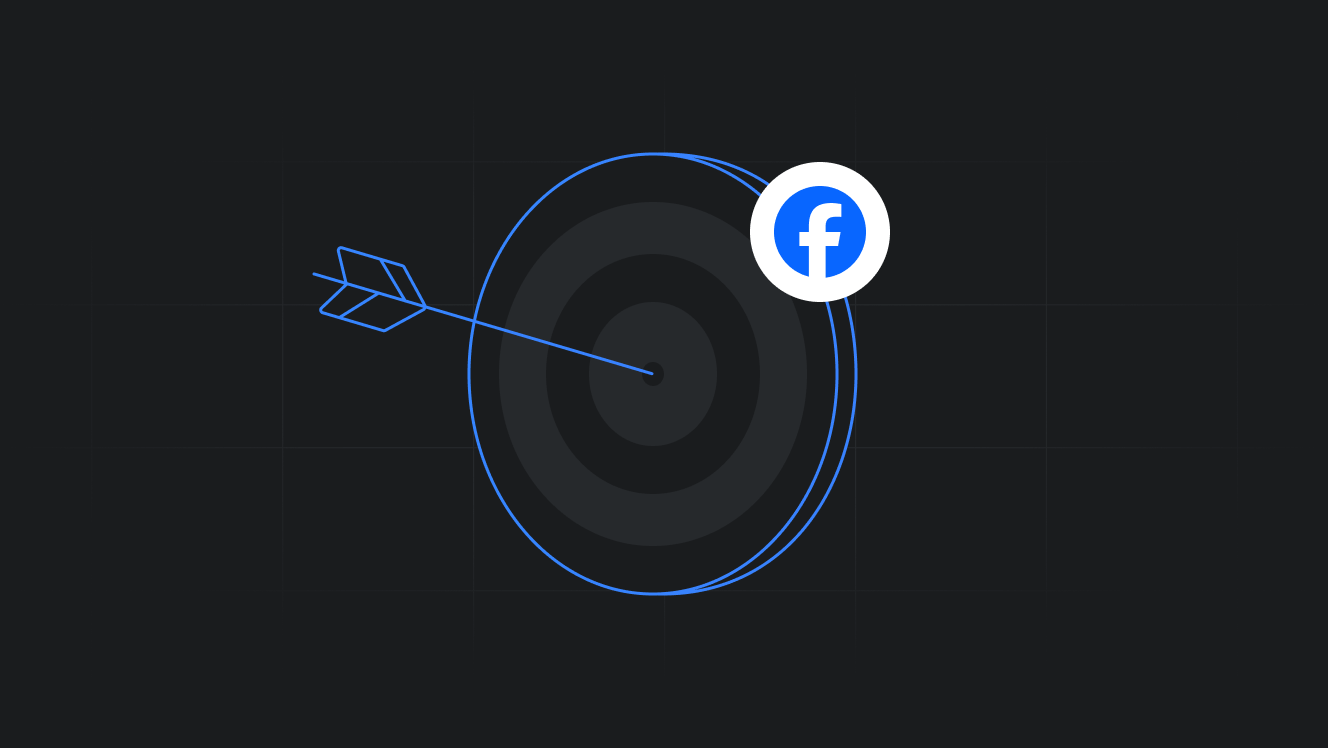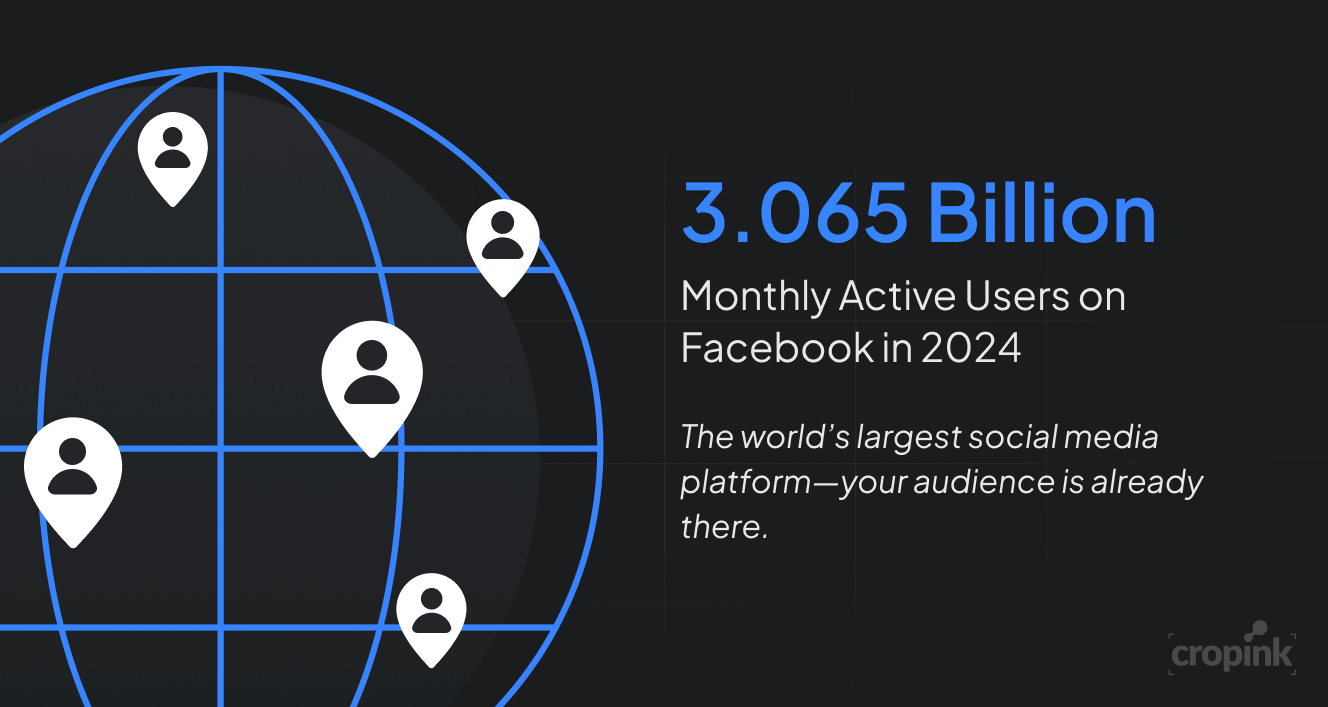Facebook Ads Targeting: Strategies, Tips & Examples for 2025
Struggling to make Facebook Ads convert in 2025? With over 3 billion users, targeting—not your product—is often the problem. Learn proven strategies to lower costs, reduce wasted spend, and reach the people most likely to buy.



Reaching the right people on Facebook is harder than ever. With over 3.065 billion monthly active users in 2024, standing out—and getting your ads in front of the right audience—can feel overwhelming.
If your campaigns aren’t converting, it’s probably not your product… it’s your targeting. Poor audience strategy leads to wasted ad spend and rising CPAs.
This guide breaks down proven Facebook ads targeting strategies, tips, and examples to help you cut through the noise, lower costs, and reach the people who are most likely to buy.
Key takeaways
- Facebook ads targeting helps you reach the right people—not just more people. With over 3 billion active users, targeting filters like interests, behaviors, and demographics keep your ads relevant and cost-efficient.
- Use core, custom, and lookalike audiences for different funnel stages. Core audiences are best for cold traffic, custom audiences re-engage existing users, and lookalikes help scale with precision.
- Audience logic (AND, OR, EXCLUDE) gives you control over who sees your ads. Combining logic rules lets you refine your targeting and reduce wasted spend on the wrong segments.
What is Facebook ads targeting and why is it so effective?
Facebook ads targeting is how you choose who will see your ads on Facebook and Instagram. It’s the opposite of throwing money at a general audience. You don’t want everyone to see your ads—you want the right people to see them.

With 3.065 billion monthly active users in 2024, Facebook has the biggest user base in the world. That’s great for reach, but it also creates a challenge: how do you find the people who actually care about your product?
That’s where targeting comes in.
Facebook allows you to show ads based on age, gender, interests, behavior, location, education level, job title, and much more. You can even target users based on how they’ve interacted with your business—like people who visited your website, watched your videos, or followed you on Instagram.
Targeting is effective because it:
- Reduces wasted ad spend by filtering out people who won’t convert
- Increases relevance, which improves your click-through rate (CTR)
- Helps you tailor your message to fit different audience types
- Lowers your cost per acquisition (CPA) by improving efficiency
You don’t need a huge budget to succeed with Facebook ads. You just need to be specific about who you want to reach. That’s why quality targeting is more important than the size of your audience. Facebook’s algorithm also performs better when you clearly define your target segments.
As Facebook strategist Dennis Yu puts it,
Using the Dollar a Day strategy… it’s not based on tricks. … It’s a cost‑effective approach to demand generation marketing that involves spending a small amount of money on advertising each day to drive traffic…

CTO at High Rise Influence
This low-budget, high-focus method aligns with modern Facebook ad strategies—especially for testing and learning fast without overspending.
The 3 main types of Facebook audiences (and when to use each)
There are three main types of Facebook audiences you can use when running ads: core audiences, custom audiences, and lookalike audiences. Each one is built differently and should be used at different stages of the funnel: awareness, consideration, and conversion.
Let’s break each one down.
1. Core audiences
Core audiences are made from Facebook’s built-in data. These are people who share specific traits—like their age, interests, hobbies, or shopping habits. You can choose these filters manually when setting up your ad set in Ads Manager.
Common core targeting filters include:
- Age: target by age range (e.g., 25–45)
- Location: countries, states, cities, or zip codes
- Gender
- Languages
- Interests: fitness, fashion, parenting, tech, etc.
- Behaviors: frequent travelers, online shoppers, gamers, etc.
For example, say you’re a brand selling protein bars. You could set up a top-of-funnel campaign like this:
- Age: 25–45
- Location: New York
- Interests: fitness, protein supplements, healthy eating
- Behavior: online shoppers
- Bonus filter: people with upcoming birthdays
You could then offer a birthday discount to get them to try your product.
Use core audiences when:
- You’re trying to find new customers
- You want to reach people who don’t know your brand yet
- You’re launching a campaign focused on brand awareness or discovery
This audience type is ideal for cold traffic campaigns.
2. Custom audiences
Custom audiences are built from your own data. These are people who have already interacted with your business in some way—either on Facebook, Instagram, your website, or through email.
Custom audiences can be built using:
- Website visits (tracked by Meta Pixel)
- App activity
- Customer lists (emails, phone numbers)
- Instagram and Facebook engagement (likes, comments, DMs, etc.)
- Video views (e.g. users who watched 25%, 50%, 75% of a video)
For example, let’s say someone visited your pricing page but didn’t buy. You can create a custom audience based on that behavior and retarget them with a reminder or a limited-time offer.
Another use case: create an audience of people who watched 75% of your product demo video. You know they’re interested—now you can hit them with a direct offer.
Custom audiences are powerful because they let you:
- Re-engage warm traffic
- Nudge people toward conversion
- Personalize your messaging for users based on their actions
Use custom audiences in mid- and bottom-of-funnel campaigns, such as:
- Abandoned cart follow-ups
- Lead nurturing ads
- Upsell or cross-sell campaigns
When done right, custom audiences usually have the highest return on ad spend (ROAS).
While custom audiences remain effective, some experts note that Meta’s algorithm now automates much of what used to be manual retargeting.
Generally remarketing is mostly unnecessary. … The algorithm is smart enough to automatically include these people now, especially if you use Advantage+ Audience or Advantage+ Shopping. … I’ll still occasionally do some micro remarketing, but it’s a very small part of my strategy.

Facebook Ads Strategist
3. Lookalike audiences
Lookalike audiences are used when you want to find new people who are similar to your best existing customers. Facebook uses your source audience (like a custom audience or conversion list) to find people with similar traits, behaviors, and interests.
Here’s how it works:
- You choose a source audience (e.g., people who bought your product)
- Facebook analyzes that group
- It then creates a new audience that “looks like” them
You can control the size of the match:
- 1% lookalike = the closest match, high relevance, smaller reach
- 2–5% = broader audience, more reach, but slightly less similar
- Super Lookalike = combine multiple match sizes to test performance
Example: One brand created a 1% Lookalike from their list of lead submitters and achieved a 49% lower CPA and 66.67% more conversions. That’s the power of letting Facebook’s machine learning find similar people at scale.
Use lookalike audiences when:
- You want to scale up your reach without guessing who to target
- You’ve built strong custom audiences and want to find more like them
- You’re launching a conversion-focused cold campaign
Lookalikes are best used in top- and mid-funnel campaigns but can also work for higher-ticket offers when layered with custom events.
How Facebook’s audience targeting logic works (AND vs. OR vs. EXCLUDE)
Understanding the logic behind Facebook targeting helps you build better audiences.
AND targeting
This means the user must meet all conditions.
Example: You target “people who like running AND yoga.” Facebook will only show ads to users who like both, not either one.
Use AND logic when you want to narrow down to high-intent segments.
OR targeting
This means the user only needs to meet one condition.
Example: You target “people who like running OR yoga.” The audience will include users who like either.
Use OR logic for broad top-of-funnel campaigns when casting a wider net.
EXCLUDE
Exclusions let you remove users from an audience.
Example: You include “people who added to cart” but exclude “people who purchased.” This avoids wasted spend.
Use exclusions to prevent overlap between campaigns (e.g., prospecting vs. retargeting) and avoid ad fatigue.
This logic ensures your budget is going to the right segments, without cross-targeting users who aren’t relevant.
How to set up Facebook ads targeting (step-by-step with screenshots)
Here’s how to build a targeted audience in Ads Manager:
- Go to Ads Manager and create a campaign.
- Choose your campaign objective (e.g. traffic, conversions).
- Go to the Ad Set level.
- In the Audience section:
- Set location: country, state, city, or zip
- Choose age range
- Pick gender
- Choose languages if needed
- Under Detailed Targeting, click:
- Browse to select from Demographics, Interests, or Behaviors
- Or Search for specific terms like “hiking” or “online shopping”
- Use Narrow Audience to apply AND logic
- Use Exclude to remove overlapping segments
- Save your audience if you plan to reuse it
- Choose placements and finalize your budget
Keep your audiences clean. Avoid combining custom, core, and lookalike targeting in a single ad set.
Facebook ads targeting vs. Google Ads targeting: what’s the difference?
Facebook Ads and Google Ads are two of the most powerful digital advertising platforms—but they work very differently.
Google Ads is based on search intent. You show ads to users when they actively search for something—like “best hiking boots” or “email marketing software.” This makes Google ideal for bottom-of-funnel conversions, because users are already in “buy mode.”
Facebook Ads, on the other hand, uses interest-based targeting. You're reaching people based on their demographics, behaviors, and interests—even if they’re not looking for your product right now. Facebook is more about creating demand, not just capturing it.
Key difference:
- Google = intent-driven (someone’s looking)
- Facebook = discovery-driven (someone’s browsing)
Why they work better together
Smart marketers use both platforms together:
- Facebook = build awareness and warm up leads
- Google = capture intent and convert
This strategy helps fill your full marketing funnel, from attention to action.
Demographic and interest targeting: what’s possible in 2025
Facebook’s detailed targeting is still one of the most advanced in digital advertising. You can target people based on real-life characteristics—both what they say and what they do.
Demographic Targeting
Available options inside Meta Ads Manager:
- Age: Choose from 13 to 65+, or customize your own range.
- Gender: All, male, or female.
- Location: Country, region, city, zip code—even a radius around a location.
- Education: Target by education level (e.g., high school, college grads).
- Relationship Status: Single, married, engaged, etc.
- Parents: Filter by child’s age (e.g., “parents of toddlers” or “parents of teens”).
- Work: Target by employer, industry, or job title.
- Income: Based on U.S. ZIP-code-level averages.
Most of this data is either self-reported by users or inferred from behavior on and off Facebook.
Use demographic targeting when your product appeals to specific life stages, professions, or household types.
Interest Targeting
Facebook builds interest profiles based on the content people engage with, pages they follow, and even their off-platform activity (when tracked).
Top categories include:
- Fitness & Wellness
- Food & Drink
- Business & Finance
- Technology
- Travel
- Sports
- Hobbies & Leisure
- Fashion & Beauty
- Parenting
Each interest has subcategories, and you can search for niche topics in Ads Manager (e.g., “trail running” instead of just “fitness”).
Use interest targeting for top-of-funnel campaigns when you're testing new audiences.
As Facebook Ads expert Paulius Melkūnas emphasizes:
The platform is huge, algorithms are smart, but still they need time. Don’t turn on your ad and after 12–24 hours turn it off. The algorithms need to learn about your audience, have patience and an extra $5. Also don’t underrate Interest targeting. You can get great results with it when kicking off with Facebook ads for beginners.… Just use 7 audience research questions… Then scale on it.

ex-Shopify | Digital Marketing Expert
Behavior Targeting
Behavior targeting focuses on how people act, not just what they say they like. Examples:
- Shopping habits (e.g., Engaged Shoppers—users who clicked "Shop Now" in the last week)
- Travel behavior (frequent travelers, international travelers)
- Device usage (iOS vs. Android, desktop vs. mobile)
- Facebook/Instagram shopping behavior
Use behavior filters to reach users who are more likely to take action, like purchasing or signing up.
How to use Facebook Audience Insights to find targeting opportunities
Meta’s Audience Insights tool (inside Business Suite) helps you see who your audience really is—not just who you think they are.
You can explore:
- Age and gender breakdown
- Top cities and regions
- Device type usage (iOS, Android, desktop)
- Pages liked (brands, media, public figures)
- Job titles and industries
Let’s say you're running ads for a plant-based meal plan.
You check Audience Insights and learn your top converters are:
- Women, age 25–34
- Living in urban areas like Chicago and NYC
- Following yoga, mindfulness, and cruelty-free beauty brands
Now you can build a high-performing segment using that exact profile.
Use Audience Insights to trim low-performing segments and double down on your top converters.
Also helpful for uncovering new interests and cross-industry overlaps.
Why you must separate campaigns by funnel stage
Here’s why you should never mix prospecting and retargeting in one campaign:
- Facebook doesn’t know who to prioritize
- Your budget gets unevenly distributed
- Your reporting becomes unclear
Structure campaigns like this:
- Prospecting = Core + Lookalike audiences (cold users)
- Re-engagement = Video viewers, Instagram engagers (warm)
- Retargeting = Add-to-cart users, past website visitors (hot)
This makes performance easier to track and lets you tailor messaging to match intent.
Use Campaign Budget Optimization (CBO) at the campaign level to distribute budget automatically between ad sets.
How to use dynamic creative ads with Facebook targeting
Dynamic Creative lets Facebook automatically test and serve the best-performing combinations of:
- Images or videos
- Headlines
- Primary text
- Calls-to-action
Here’s how it works:
- In your ad set, toggle on “Dynamic Creative.”
- Upload multiple versions of each creative asset.
- Facebook mixes and matches them in real time.
This is especially effective for prospecting campaigns. You can test different hooks and angles without running 10 separate ads.
Let the algorithm find the best combination for each audience segment.
Final thoughts
Facebook ads targeting is still incredibly effective in 2025 — but only if you’re using the right structure and tools. With 3.065 billion users, precision matters more than ever.
If you’re running catalog or product ads, Cropink helps you move faster. Design dynamic creatives, connect your feed, manage campaigns, and boost performance — all in one place.
Start free, no cards or trials. Just better ads, built smarter.
👉 Try Cropink
FAQs
Facebook ads targeting works by showing your ads to specific people based on traits like age, interests, behaviors, and location.
The difference is: custom audiences target people who’ve interacted with you, while lookalike audiences find new people similar to them.
Yes, Facebook ads targeting is still very effective in 2025 when used with the right structure and optimization.
To exclude audiences, go to the “Exclude” section when setting up your ad audience in Facebook Ads Manager.
Yes, you can combine interests and lookalikes, but it’s better to keep them separate for clean testing and budget control.
Sources
- Sproutsocial. 31 Facebook statistics marketers should know
- KlientBoost. Facebook Ad Targeting: 6 Tips to Maximize Your ROI

Ansherina helps brands create powerful digital marketing and performance marketing strategies. With a passion for ad design and audience engagement, she is dedicated to making brands more visible and impactful.

Leszek is the Digital Growth Manager at Feedink & Cropink, specializing in organic growth for eCommerce and SaaS companies. His background includes roles at Poland's largest accommodation portal and FT1000 companies, with his work featured in Forbes, Inc., Business Insider, Fast Company, Entrepreneur, BBC, and TechRepublic.
Related Articles
Black Friday is the most competitive shopping event of the year, and your ad creatives will determine how much you sell. Find out how to create Meta Catalog Ads that attract shoppers and encourage them to convert without hesitation.

Cyber Monday has changed from a desktop-first sales day to a mobile-first extension of Black Friday weekend. We’ll show you how to adjust your Meta Catalog Ads strategy for Cyber Monday shoppers who are more deliberate, comparison-focused, and ready to buy online.

Discover 11 tested ways to customize your Facebook Dynamic Product Ads for better performance. Learn how you can create DPAs that draw attention and increase conversions effortlessly.

Learning the difference between internal labels and custom labels can drastically change how your Meta catalog campaigns perform. This guide covers what makes them different and which one you should be using.

Learn how to manually add Site Links in Facebook (Meta) Ads, enable them in Advantage+ Creative, and track performance using URL parameters, Custom Conversions, and GA4.

Learn the Meta ads targeting options that truly work in 2025. Broad targeting paired with first-party signals cuts CPA by 32%. 65% of advertisers now scale profitably using Advantage+ campaigns. Includes playbooks, pitfalls, and setup checklists.

Find out everything you need to know about budgeting options in Meta Ads Manager, performance benchmarks, testing strategies, and how to get better results even with a small budget.

With global ad spend set to reach $1.1 trillion by 2025 and 73% of revenue driven by digital ads, brands need smarter tools. Discover the best alternative to Meta Overlays for product ads, from Cropink to Smartly.io, to scale catalog campaigns, improve performance, and stand out in competitive feeds.

Meta Pixel may seem technical, but it’s simpler than it looks. We explain what the Meta Pixel code is, how to install it, and how to troubleshoot common errors. You’ll also see a meta pixel code example and learn how to use Pixel data for retargeting, audience building, and measuring ad performance.

Running Facebook ads doesn’t have to be expensive or complicated. Learn how to define clear objectives, craft compelling visuals and copy, and target the right audience to maximize your ad performance without overspending.

With over 10 million advertisers on Facebook, standing out isn’t easy—but free ad credits can help. Learn how to score and maximize Facebook ad credits to test campaigns, cut costs, and boost performance—without spending a dime.

Facebook brand awareness campaigns fail when treated as standalone ads, but they're useful for filling your retargeting pipeline. This guide reveals expert strategies for targeting the right audiences and avoiding the budget-draining mistakes that kill most awareness campaigns before they deliver results.

How Can Cropink Help?
Start with Cropink is easy and free
No credit card required